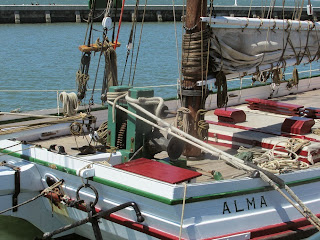 |
| Scow Schooner Alma |
If your trip west takes you to the San Francisco Bay area you'll want to plan a stop at the San Francisco Maritime National Historic Park where not only is the Alma ported but also several other very historic vessels including the steam ferry Eureka and the tall ship Balclutha.
Located in the Fisherman's Wharf area, the San Francisco Maritime National Historical Park offers the sights, sounds, smells and stories of Pacific Coast maritime history. Included are a library and research center. The Visitor Center is located across the street from Hyde Street Pier. The Visitor Center address is: 499 Jefferson Street, San Francisco. Hours are 9:30A to 5P. The park is closed on Thanksgiving, Christmas and New Year's Days.
Two additional vessels located adjacent to the park at Fishermans Wharf and well worth a visit to are the World War Two submarine USS Pampanito and the Liberty Ship the Jeremiah O'Brien.
Two additional Western Trips photo article links of historic ships at the park include...
The Passenger Ferry Eureka
The Tall Ship Balclutha
 |
| Schooner Alma, San Francisco, CA |
The Alma is the last of about 400 scow schooners that were locally built. The Alma was built by Fred Siemer's shipyard at Hunters Point. Siemer built two scow schooners at his Hunters Point facility and named one for his daughter Adelia and the other for daughter Alma. The Alma's home port was usually Mission Creek which is adjacent to the current Giants ballpark.
The boat was designed to haul salt, lumber, hay, bricks and just about any bulk cargo. The flat bottomed Alma was able to navigate the shallow parts of the bay and delta. Back during the latter 1800's and during the first few decades of the 1900's, shipping freight on a scow schooner like the Alma was considered the least expensive way to move goods all along the Bay Area. It's said that the Alma during almost all of her long career operated in the immediate San Francisco Bay area.
The Scow Schooner
The maritime term "scow" is used to describe a wide, flat-bottomed, square ended vessel without a deep keel. Scows
were often equipped with a centerboard or leeboard. When in shallows these boards could be pulled up letting navigation in very shallow waters possible including sections along the Sacramento and San Joaquin Rivers. While the scow schooners were primarily built to be sailing vessels they could also be poled while in the shallows. Scows also had the ability of coming right onto the beach and intentionally grounding. These obviously were very versatile vessels.
The descriptive term "Schooner" refers to the arrangement of
masts and sails. A schooner has at least two masts, with the forward
mast being shorter than or the same height as the aft
mast. Today, these type of vessels are not easy to find. If you looked about one hundred years ago you'd see them everywhere. The scow schooner was primarily used for cargo transport on coastal and inland waters. These vessels were simply designed for hard work and heavy hauling.
 |
| Deck of the restored schooner Alma |
In 1918 Alma had her masts removed. For about eight years afterward she was essentially used as a barge hauling salt until a new owner purchased her in 1926. The new owner installed a gas engine and the Alma was primarily used to carry oyster shells to Petaluma on the north bay.
The scow schooner hauling business came to an end when trucks were mostly used for transporting cargo on newly completed highways. Operating the Alma profitably came to an end in 1957 when she retired from service.
The Alma is 100 feet in length, is 22.6 feet wide and draws about 3 1/2 feet of water.
Restoring the Alma
 |
| Bay view from the SF National Maritime Historic Park |
The Alma was sold to the state of California in 1959. Because the Alma had a long history of work all around the Bay Area local historians were well aware of her long service. It was this knowledge that led to the effort for her restoration. The restoration didn't begin however until 1964 and lasted for several years.. The National Park Service took ownership of the Alma in 1978 and the vessel was designated a National Historic Landmark in 1988.
Two good books to explore the subject further include Scow Schooners of San Francisco Bay by authors Roger R. Olmstead and Nancy Olmstead and San Francisco Maritime Park: The Story Behind the Scenery by authors Stephen J. Canright, Lynn T. Cullivan and William G. Thomas.
(Article and photos copyright 2013 Western Trips)

